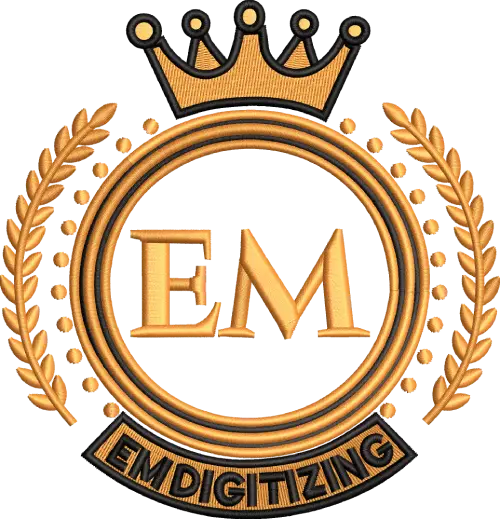Wenn es darum geht Welcher Stoff soll zum Sticken verwendet werden?, Es ist nicht nur eine Frage der Präferenz, es ist der Unterschied zwischen einem makellosen Finish und einem frustrierenden Chaos. Wenn bei Ihnen schon einmal ein Design schief oder wellig ausgefallen ist, Die Chancen stehen gut, dass der Stoff Teil des Problems war. So, Wie treffen Sie die richtige Wahl??
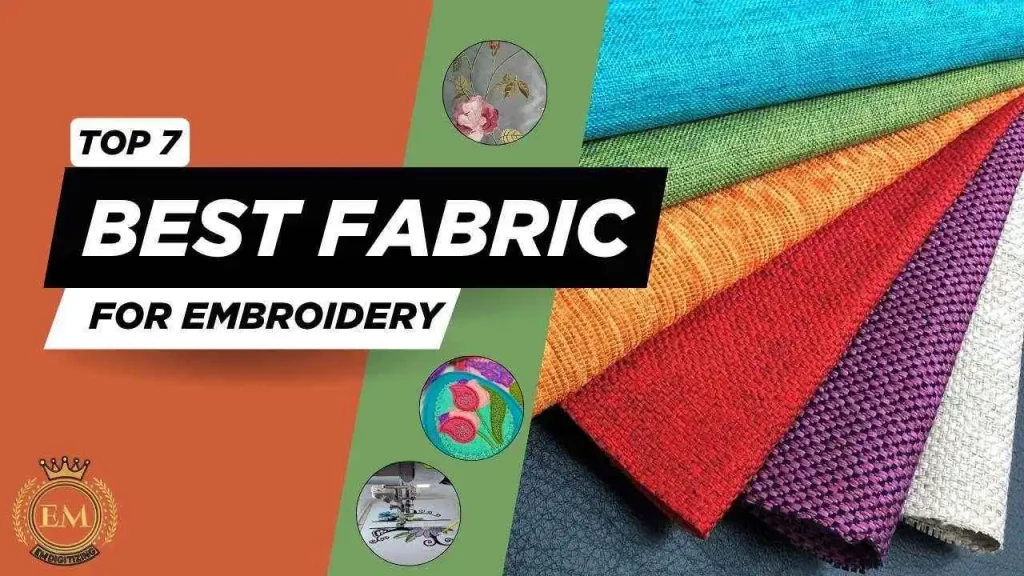
Lassen Sie uns sieben herausragende Stoffe durchgehen, die Ihre Maschinenstickerei aufwerten können, Von einsteigerfreundlichen Basics bis hin zu fortschrittlichen Materialien für dekorative Details.
Welcher Stoff für Stickereien verwendet werden | Top -Stoff -Picks?
Die besten Stoffe für die Maschinenstickerei – unsere Wahl
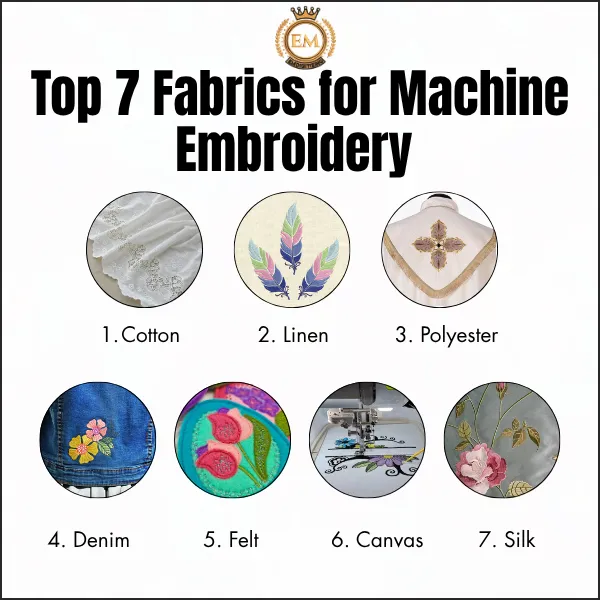
Die Wahl des richtigen Stoffes ist die Grundlage für einen Erfolg Maschinenstickerei Projekt.
Manche Stoffe sind stabiler, einfacher einzuspannen, und bieten eine bessere Stichqualität als andere.
Hier sind unsere Top-Stoffauswahl, die beim Maschinensticken stets hervorragende Ergebnisse liefert:
- Baumwolle
- Leinen
- Polyester
- Denim
- Gefühlt
- Leinwand
- Seide
1. Baumwolle: Dein bester Freund beim Sticken
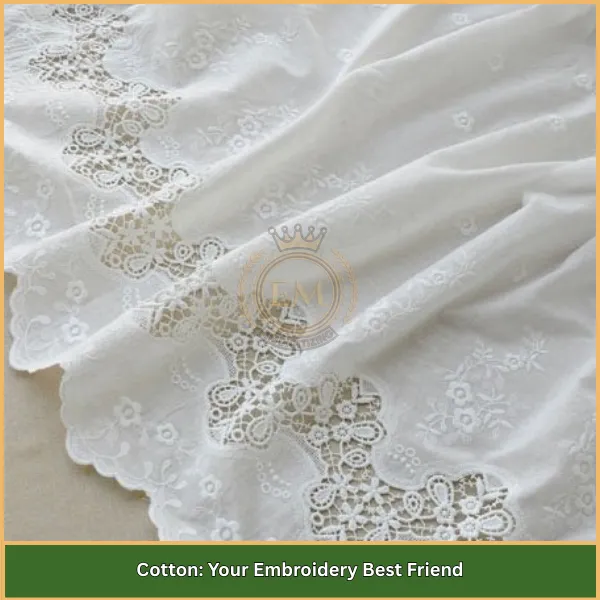
Es ist eines der am häufigsten verwendeten Stoffe in Stickerei, besonders für Anfänger. Es handelt sich um eine Naturfaser, die für ihre glatte Textur bekannt ist, Mittelgewicht, und dicht gewebt. Diese Eigenschaften machen es extrem einfach, es einzuspannen und zu stabilisieren, hilft Ihnen dabei, saubere und gleichmäßige Nähte zu erzielen.
Baumwolle ist sowohl leicht als auch mäßig dicht Entwürfe mit Leichtigkeit und funktioniert gut mit den meisten Stabilisatoren, wie Tear-Away oder Cut-Away. Das Vorwaschen von Baumwolle ist wichtig, um zukünftiges Einlaufen zu verhindern, vor allem, wenn Sie tragbare Gegenstände herstellen.
Der Stoff ist in verschiedenen Farben erhältlich, Drucke, und Fadenzahl, wodurch es vielseitig für die Inneneinrichtung geeignet ist, Bekleidung, und Quiltprojekte.
Preis reicht von $5 zu $12 pro Yard, je nach Qualität und Marke.
Vorteile:
- Einfach einzuspannen und vorzubereiten
- Tolle Stichklarheit
- Große Auswahl an Gewichten und Farben
Nachteile:
- Läuft ein, wenn es nicht vorgewaschen wird
- Bildet leicht Falten
Viele Fachleute denken darüber nach Welcher Stoff eignet sich am besten zum Besticken? beim Start.
2. Leinwand: Für Projekte, die Struktur brauchen
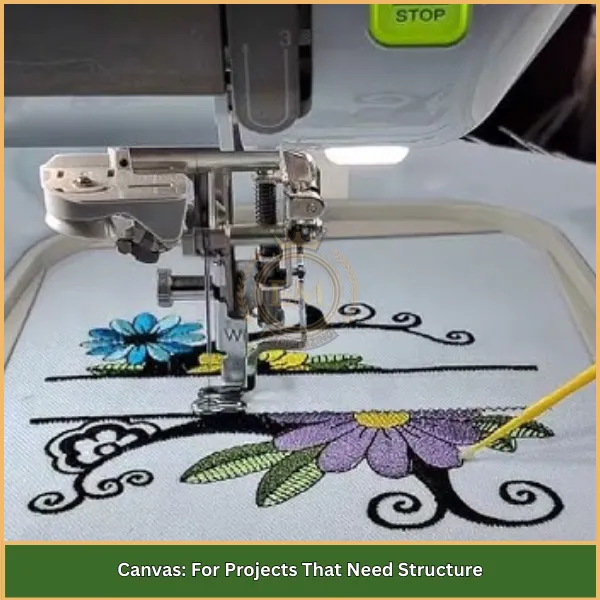
Es handelt sich um einen strapazierfähigen, gewebten Baumwollstoff, der sich ideal für auffällige Motive eignet, Strukturierte Stickerei.
Mit seiner dicken, langlebige Textur, Canvas ist die erste Wahl für Artikel wie Tragetaschen, Wandbehänge, Banner, und Sitzbezüge.
Die Steifheit von Leinwand macht sie für feine oder komplizierte Muster weniger geeignet, Aber es zeichnet sich durch eine hohe Stichdichte aus.
Denn das Spannen einer Leinwand kann schwierig sein, Viele Sticker lassen es stattdessen über das Vlies schweben.
Es funktioniert gut mit einem festen ausgeschnittenen Stabilisator und bietet minimale Verschiebungen beim Nähen. Die Textur der Leinwand verleiht Ihren Projekten ein professionelles und robustes Finish. Erwarten Sie, zu zahlen $6 zu $15 pro Yard, basierend auf Gewicht und Mischung.
Vorteile:
- Hält große Designs ohne Verzerrung
- Doesn’;t-Verschiebung, sobald stabilisiert
Nachteile:
- Erfordert starke Nadeln
- Kann für empfindliche Designs zu dick sein
If you’;Nehmen Sie wieder robuste Projekte in Angriff, das ist wohl das Bester Stoff für Stickereien für dauerhafte Ergebnisse.
3. Gefühlt: Einfach, Erschwinglich, und anfängerfreundlich
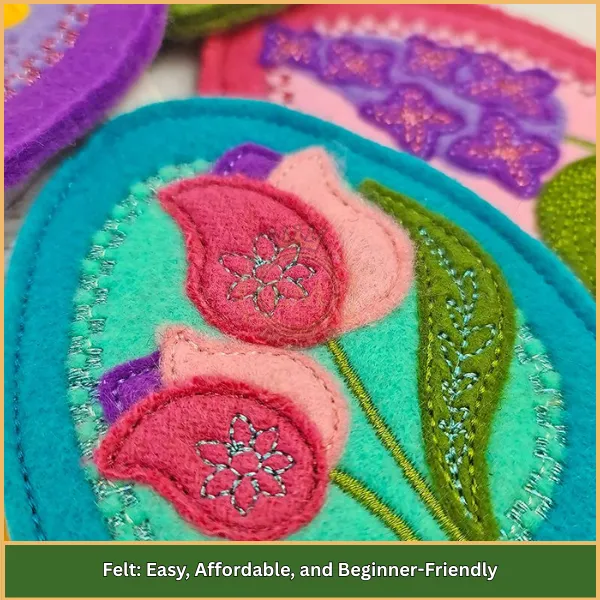
Es handelt sich um einen Vliesstoff aus natürlicher Wolle oder synthetischen Fasern, Dies macht es zu einer fantastischen Wahl für neue Sticker oder Bastler.
Es ist weich, dicht, und franst nicht aus, Dadurch entfällt die Notwendigkeit einer Kantenbearbeitung.
Filz eignet sich hervorragend für kleine Projekte wie Flicken, Applikationen, Schlüsselanhänger, Abzeichen, und Feiertagsdekorationen.
Es unterstützt einfache Designs mit geringer Stichdichte. Weil ihm ein Gewebe fehlt, es ist extrem einfach zu spannen, and it typically doesn’t require backing unless you’;Ich verwende es erneut für ein dichteres Muster.
Filzplatten sind auch in verschiedenen Stärken und Farben erhältlich. Es ist äußerst erschwinglich, normalerweise liegt der Preis zwischen $3 zu $8 pro Yard, oder sogar weniger für kleinere Bastelstücke.
Vorteile:
- Weich und stabil
- Minimale Vorbereitung erforderlich
- Erfordert keine Kantenbearbeitung
Nachteile:
- Unterstützt keine schweren oder dichten Designs
- Kann sich unter Druck leicht dehnen
Dies macht es ideal für diejenigen, die sich fragen Welcher Stoff wird zum Sticken verwendet? wenn man die Dinge einfach hält.
4. Seide: Luxuriös, aber anspruchsvoll
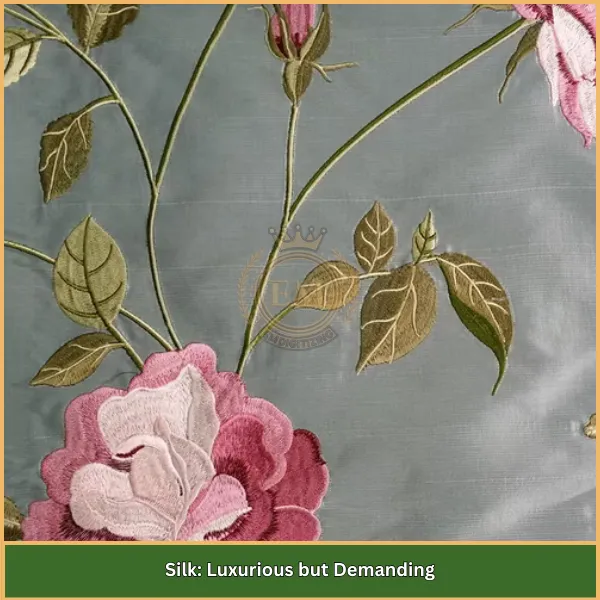
Es ist ein Leichtgewicht, glatt, und luxuriöser Stoff, beliebt für seinen natürlichen Glanz und sein elegantes Finish.
Es wird am häufigsten für hochwertige oder dekorative Stickereien wie Brautstücke verwendet, gerahmtes Kunstwerk, oder Erbstücke.
Jedoch, Seide ist empfindlich und kann durch zu enges Einspannen oder hohe Stichdichte leicht beschädigt werden.
Anstatt Seide direkt einzuspannen, Viele Sticker lassen es mit temporärem Klebespray oder Klebeband über dem Stabilisator schweben.
Kombinieren Sie es mit einem abwaschbaren oder nicht sichtbaren Netzstabilisator und verwenden Sie immer feine Nadeln, um ein Reißen zu vermeiden.
Seide erfordert langsame Maschinengeschwindigkeiten und Probestiche. Der Preis für Seide liegt zwischen $15 zu $40 pro Yard, je nach Art und Qualität.
Vorteile:
- Elegantes Finish mit natürlichem Glanz
- Ideal für feine Ziernähte
Nachteile:
- Schwierig einzuspannen
- Unter Druck leicht beschädigt
Dieser luxuriöse Stoff beantwortet die Frage vieler Handwerker: Welchen Stoff verwendest du zum Sticken? Das braucht ein High-End-Finish.
5. Polyester: Ein kommerzielles Kraftpaket
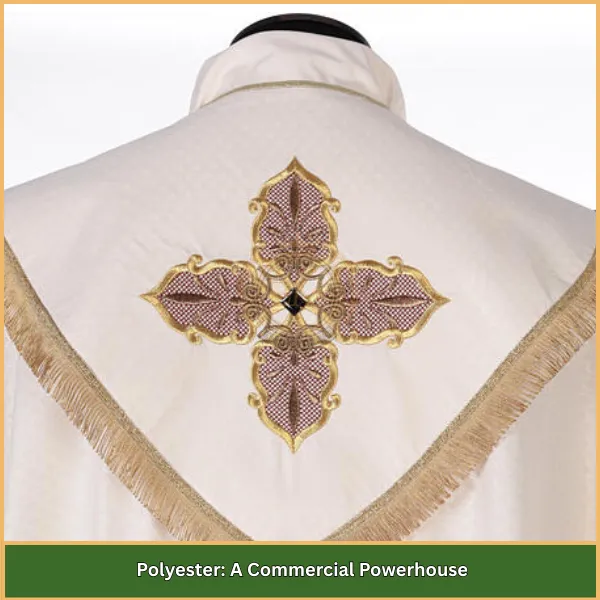
Es handelt sich um eine synthetische Faser, die zu einem beliebten Stoff für kommerzielle Stickereien geworden ist.
Man findet es häufig in Sportbekleidung, Uniformen, kühlen, und Werbebekleidung. Polyester ist leicht, stark, farbecht, und resistent gegen Schrumpfen und Falten.
Es unterstützt Designs mit leichter bis mittlerer Dichte und funktioniert am besten mit Stabilisatoren wie No-Show-Mesh oder Tear-Away. Jedoch, es hat eine rutschige Textur, Daher ist sorgfältiges Einspannen oder Schweben wichtig.
Da es hitzeempfindlich ist, Sie sollten Ihre Bügeleinstellungen immer testen.
Besonders beliebt sind Polyestermischungen aufgrund ihrer Strapazierfähigkeit und der Fähigkeit, häufigem Waschen standzuhalten. Die Preise liegen im Allgemeinen zwischen $3 zu $10 pro Yard, je nach Qualität.
Vorteile:
- Schrumpft und knittert nicht
- Ideal für Massenproduktion und Haltbarkeit
Nachteile:
- Kann sich im Reifen verschieben
- Hitzeempfindlich und erfordert Bügeln bei niedriger Temperatur
Many production shops agree it’;ist das Der beste Stoff zum Besticken bei Wiederholungsarbeiten.
6. Leinen: Für einen natürlichen und strukturierten Look
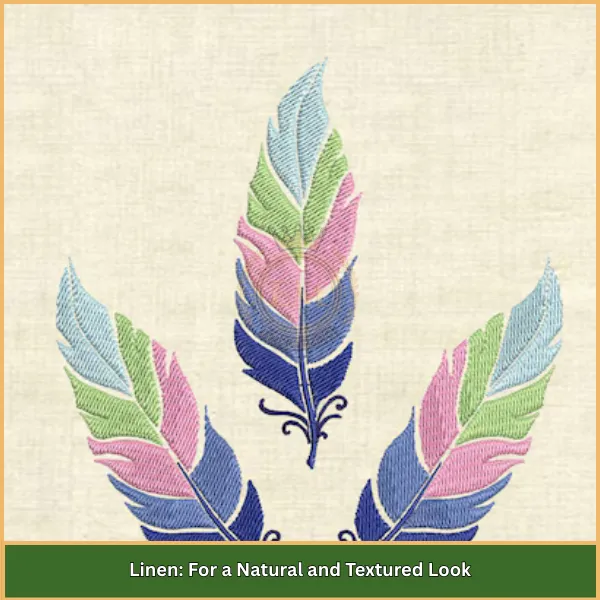
Es handelt sich um eine Naturfaser aus Flachs, die wegen ihres Vintage-Looks und ihrer atmungsaktiven Textur beliebt ist.
Es ist etwas lockerer gewebt als Baumwolle, kann Stickstiche aber gut halten, wenn es richtig stabilisiert wird.
Leinen ist perfekt für Monogramme, Erbstücknaht, und elegante Wohnaccessoires wie Geschirrtücher, Läufer, und Wandkunst.
Es franst leichter aus, Daher wird eine Kantenbearbeitung empfohlen.
Verwenden Sie immer ein starkes Vlies und erwägen Sie, den Stoff vor dem Nähen zu stärken, um die Handhabung zu verbessern.
Auch das Vorwaschen ist wichtig, um das Einlaufen zu reduzieren. Bettwäsche kostet normalerweise $10 zu $25 pro Yard, je nach Fadenzahl und Mischung.
Vorteile:
- Natürlich, strukturierter Look
- Bequem und klassisch
Nachteile:
- Locker gewebt und franst leicht aus
- Erfordert eine ordnungsgemäße Stabilisierung
Auf der Suche nach Charme und Tradition? Das könnte sein Welcher Stoff eignet sich am besten zum Sticken? mit einem traditionellen Flair.
7. Denim: Robust und im Trend
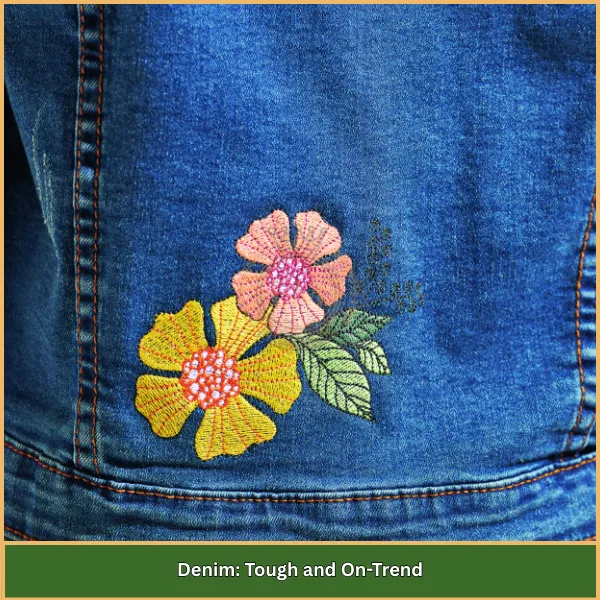
Es handelt sich um einen schweren Baumwoll-Twill-Stoff, der Stickereien sowohl Haltbarkeit als auch Stil verleiht.
Es wird häufig für Jacken verwendet, Jeans, Tragetaschen, Schürzen, und Zubehör.
Das enge Gewebe von Denim unterstützt schwere Stichdesigns, Daher ist es ideal für auffällige Grafiken und Patches.
Wegen seiner Dicke, es erfordert eine stabile Nadel (90/14 oder höher) und ein starker Cut-Away-Stabilisator.
Das Spannen von Denim kann schwierig sein, Daher ziehen es einige Benutzer vor, es zu schweben.
Um bessere Ergebnisse zu erzielen, müssen Sie möglicherweise die Maschinengeschwindigkeit reduzieren. Denim hält häufigem Waschen und Tragen stand. Die Preise liegen normalerweise zwischen $7 zu $18 pro Yard, je nach Gewicht und Qualität.
Vorteile:
- Ideal für dichte Nähte und Haltbarkeit
- Stilvoll und langlebig
Nachteile:
- Anspruchsvoll beim Reifen
- Erfordert langsamere Stichgeschwindigkeiten und stärkere Nadeln
Es zeichnet sich oft als robuste Wahl aus Welcher Stoff soll zum Sticken verwendet werden? bei der Arbeit an Kleidung oder Ausrüstung.
Häufige Fehler bei der Auswahl des Stoffes zum Sticken
Viele Anfänger machen bei der Stoffauswahl die gleichen Fehler, Dies kann sich auf die Qualität der Stickerei auswirken. Hier sind die häufigsten:
- Wählen Sie dehnbaren Stoff ohne Stabilisator: Stretchstoffe wie Jersey oder Spandex können das Design verzerren, wenn sie nicht mit einem ausgeschnittenen Stabilisator kombiniert werden.
- Auf das Vorwaschen verzichten: Stoffe wie Baumwolle und Leinen schrumpfen nach dem Waschen. Wenn nicht vorgewaschen, Ihr Design kann sich nach dem ersten Waschen verziehen.
- Verwendung falscher Rahmentechniken: Wenn Sie den Stoff zu fest oder zu locker in den Stickrahmen ziehen, führt dies zu ungleichmäßigen Nähten oder Verbrennungen des Stickrahmens.
- Die Nadel passt nicht zum Stoff: Die Verwendung des falschen Nadeltyps oder der falschen Nadelstärke kann zu Löchern führen, Threads brechen, oder den Stoff beschädigen.
Design zu dicht für den Stoff: Starke Nähte auf leichtem Stoff können zu Kräuselungen und Rissen führen. Passen Sie die Designdichte immer an die Stoffstärke an.
Tipps zur Fehlerbehebung, welcher Stoff zum Sticken verwendet werden soll
Nach der Auswahl Ihres Stoffes treten immer noch Probleme auf? Hier finden Sie bewährte Lösungen:
- Faltenbildung nach dem Nähen: Dies wird häufig durch lockere Einspannung oder schwache Stabilisatoren verursacht. Verwenden Sie ein ausgeschnittenes Vlies und stellen Sie sicher, dass Ihr Stoff eng an der Trommel befestigt ist.
- Stoff rutscht im Reifen: Häufig bei glatten Stoffen wie Seide oder Polyester. Umwickeln Sie den Innenrahmen mit Köperband oder glätten Sie den Stoff mit Stickband.
- Design ist nicht richtig ausgerichtet: Verursacht durch instabilen Stoff oder zu hohe Stichgeschwindigkeit. Verwenden Sie einen festen Stabilisator und reduzieren Sie die Geschwindigkeit.
- Nadellöcher im Stoff: Dies passiert bei empfindlichen Stoffen, wenn eine dicke oder stumpfe Nadel verwendet wird. Verwenden Sie ein scharfes Messer, Verwenden Sie eine kleinere Nadel und reduzieren Sie die Stichdichte.
- Dehnbarer Stoff verursacht wellige Designs: Verwenden Sie immer ein ausgeschnittenes Vlies und vermeiden Sie, dass der Stoff beim Einspannen gedehnt wird.
Schneller Vergleich der besten Stoffe für Maschinenstickerei
Stoff | Texture &; Fühlen | Haltbarkeitsstufe | Einfaches Einspannen | Ideale Projekte | Stabilisatorspitze |
Baumwolle | Glatt und atmungsaktiv | Mäßig | Sehr einfach | Servietten, T-Shirts, Quiltblöcke | Abreißbar oder abschneidbar |
Leinwand | Fest und strukturiert | Sehr hoch | Herausfordernd (schweben) | Tragetaschen, Wohnkultur, Banner | Ausgeschnitten |
Gefühlt | Weich und dicht | Niedrig bis mittel | Sehr einfach | Patches, Applikationen, kleine Kunsthandwerke | Optional oder zum Abreißen |
Seide | Weich mit natürlichem Glanz | Niedrig | Sehr schwierig | Brautaccessoires, gerahmte Kunst | Kein sichtbares Netz oder abwaschbar |
Polyester | Rutschig und dehnbar | Hoch | Mäßig | Uniformen, Sportbekleidung, kommerzielle Kleidung | Nicht sichtbares oder abreißbares Netz |
Leinen | Grob und atmungsaktiv | Mäßig | Mäßig | Monogramme, Erbstück-Dekor | Ausgeschnitten |
Denim | Dick und robust | Sehr hoch | Hart | Jacken, Jeans, Rucksäcke | Ausgeschnitten |
Endgültiges Urteil
Inzwischen, Sie haben diese Wahl gesehen Welcher Stoff soll zum Sticken verwendet werden? wirkt sich auf jeden Teil Ihres endgültigen Designs aus, vom Reifen bis zur Haltbarkeit. Wählen Sie basierend auf Ihren Designanforderungen aus, Testen Sie Ihr Setup, und bereiten Sie Ihren Stoff auf intelligente Weise vor.
Erinnern, ob es sich um ein Hobbyprojekt oder ein professionelles Stück handelt, EMdigitizing kann Ihr machen Entwurf fit perfekt. Wir bieten individuelle, für Ihren Stofftyp optimierte Digitalisierung mit garantierter Qualität, 24/7 Unterstützung, und ein 50% Rabatt auf Ihre erste Bestellung.
So JETZT BESTELLEN und erlebe dich selbst!
Häufig gestellte Fragen
Ein mittelschwerer Stoff, zwischen 150–250 GSM, eignet sich am besten zum Sticken. Es ist nicht zu dick oder zu dünn. Es hält die Stiche gut und lässt sich leicht mit der Nadel durchstechen. Dadurch eignet es sich sowohl für Hand- als auch für Maschinenstickereien.
Die drei Haupttypen sind:
- Gewebte Stoffe (wie Baumwolle und Leinen) – Beste Stabilität und einfaches Nähen
- Vliesstoffe (wie Filz) – Ideal zum Anfertigen von Flicken
- Strickstoffe (wie Trikot) – Lässt sich gut mit Stabilisator und Pflege verarbeiten
Gewebte Stoffe sind die einfachste und häufigste Wahl.
Ja, Sie können fast jeden Stoff besticken, solange eine Nadel hindurchpasst. Aber es ist besser, mit nicht dehnbaren Stoffen wie zu beginnen Baumwolle, Leinen, oder Leinwand. Mit ihnen lässt sich leichter arbeiten, besonders für Anfänger.
Der Stoff hinter Ihrem Hauptstoff wird a genannt Stabilisator oder Stickunterlage. Es unterstützt die Stiche und verhindert, dass sich Ihr Design bewegt oder Falten wirft. Verwenden abreißbare Rückseite für starke Stoffe und ausgeschnittener Träger für dehnbare oder dünne
Wählen Sie ein mittelschwer, dicht gewebter Stoff Hergestellt aus natürlichen Materialien wie Baumwolle oder Leinen. Ebenfalls, Denken Sie darüber nach, wie der Artikel verwendet werden soll. Wählen Sie langlebig, Nicht einlaufender Stoff, wenn er häufig gewaschen oder getragen wird. Guter Stoff trägt dazu bei, dass Ihr Design länger hält und besser aussieht.
